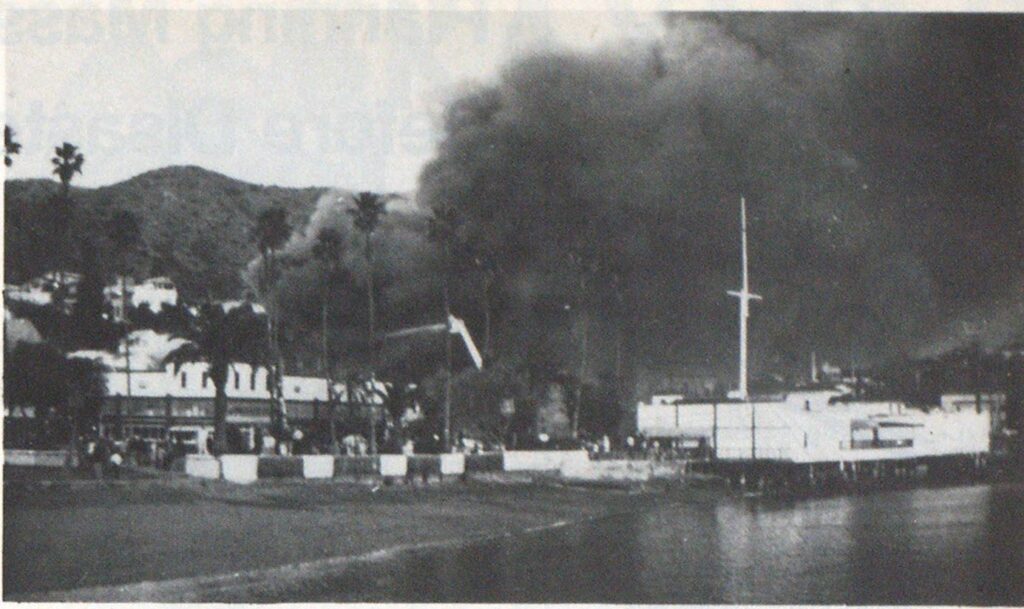
Wood Hotel, Restaurant Swept by $1 Million Fire
CAPT.
A million-dollar fire raged through a restaurant and an adjacent three-story hotel in Avalon, Calif., on Santa Catalina Island. The buildings were over 60 years old and mostly of wood-frame construction.
Avalon is a small tourist community on Santa Catalina Island, some 26 miles west of Long Beach, Calif. Permanent population is around 1800. The fire department is part-paid, with five fulltime personnel, Chief Jack Goslin, a captain and three engineers, and 20 volunteers.
At 5:28 a.m. March 4,1979, an alarm was received at the fire station reporting smoke in the area of the involved structure in the heart of the downtown business district. A first alarm was sounded on the fire siren to notify volunteers and off-duty personnel.
Initial response was with Engine 1, a small attack pumper, and Engine 2, a 1000-gpm pumper. Upon arrival, the Hurricane Cove (a restaurant and cocktail bar), a wood structure approximately 30 X 140 feet, was well involved. Engine 1, manned by Chief Goslin, was used primarily as the command post because of the severity of the fire. Engine 2, manned by an off-duty captain and engineer, made a straight lay from a hydrant at the northwest side of the structure. This line was first advanced to the front of the Hurricane and later was used on the Metropole Ave. side of the Waikiki Hotel.
Engine 2 then made a reverse lay to a hydrant on Sumner Ave. Two 2 1/2-inch lines from this engine were advanced to the roof of the clothing store adjoining the Hurricane Cove. With volunteers now arriving on the scene, an additional 2 V2 -inch line was wyed to two 1 1/2-inch lines, which were stretched to the 10foot-wide alley behind the Hurricane. Two preconnected 1 1/2-inch lines were advanced to both the front and fear portions of the Hurricane.
At 5:31 a.m., a second alarm was sounded. This alarm brought Engine 3 (a 50-foot elevating platform), Unit 4 (a utility truck with lights) and Rescue 16 with additional breathing apparatus. Also responding at this time was Engine 55, Patrol 55 and Patrol 155 from the Los Angeles County Fire Department, which protects all of Santa Catalina Island except for 1 1/4-square-mile Avalon.
Roof collapses
Upon arrival of Engine 3, the roof of the Hurricane was venting itself and then collapsed. Because of the excessive layers of tarpaper on the Hurricane roof, the fire was difficult to control. The heat from this fire radiated to the upper story of the Waikiki Hotel.
On the first floor of the hotel, a wood structure 36 X 165 feet, were the Waikiki Restaurant and Bar and four stores. One was a bakery that had not yet been opened. The next store was unoccupied, then there were a photograph shop and an arts and crafts store. All stores faced Metropole Ave. The hotel contained 20 rooms. It was closed at the time except for a caretaker and the owner, who were evacuated right after the first alarm.
Engine 3 set up operations directly in front of the Hurricane. This engine was supplied by three 2‘/2-inch lines from a hydrant northwest of the structure on Metropole Ave. After boom operation was established, both 1 V-i-inch preconnects were pulled and advanced into the interior of the hotel.
Two lines advanced
Engine 55 (L.A. County Fire Department) operated from a hydrant west of the fire on Metropole Ave. Two 1V2 inch lines were advanced to the west portion of the fire and to the roof of the building west of the alley.
As the fire progressed in the hotel, interior lines were temporarily withdrawn because of the intense heat and smoke. At this time, only heavy streams were in use.
At 5:45 a.m., a third alarm was sounded. Although all available equipment was in use, citizens in the community were aware that a third alarm is a disaster situation requiring additional help. Approximately 20 residents were used to help man lines.
The fire was declared under control at 9 a.m. and overhaul continued for several hours.
There are several factors in this fire that are important. One, approximately 500,000 gallons of water was used in the extinguishment of the fire. In this community, that means salt water. To the best of my knowledge, we are the only community in the United States that uses salt water as the primary source of fire protection. This contributed to the additional water damage that occurred in the four stores below the hotel. There was no fire damage to these stores.

A major problem in extinguishment was the numerous layers of tarpaper on the roof of the Hurricane. Spread of fire to the clothing store, south of the Hurricane, was averted by a brick wall and continuous cooling by heavy streams.
It was discovered later that at least two different individuals had passed the fire location and smelled smoke. This was approximately an hour prior to the actual alarm. Roth individuals looked for the source of the smoke, but they failed to notify anyone. The probable cause was from cigarettes dumped into a plastic waste basket by the bar.

